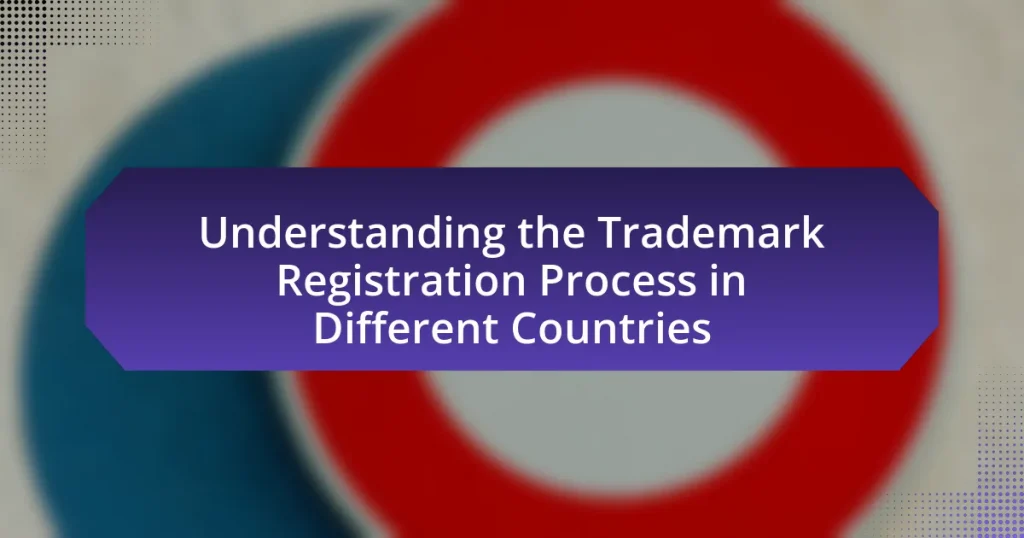Trademarks are essential legal tools for brand protection, serving to distinguish a company’s goods or services from those of competitors. They provide exclusive rights to owners, preventing unauthorized use and maintaining brand integrity and consumer trust. The article explores the functions of trademarks in safeguarding brands, the key elements that constitute a trademark, and the various types of trademarks available. It also discusses the processes involved in trademark registration, the challenges faced in brand protection, and strategies for effective trademark management, including monitoring and enforcement. Additionally, the role of legal counsel and available resources for trademark education are highlighted, emphasizing the importance of proactive trademark management in maintaining brand value and loyalty.

What is the Role of Trademarks in Brand Protection?
Trademarks play a crucial role in brand protection by legally distinguishing a company’s goods or services from those of others. They provide exclusive rights to the owner, preventing unauthorized use by competitors, which helps maintain brand integrity and consumer trust. According to the World Intellectual Property Organization, trademarks can enhance brand recognition and value, as they signify quality and reliability to consumers. This legal protection also allows businesses to take action against infringement, thereby safeguarding their market position and investment in brand development.
How do trademarks function in protecting brands?
Trademarks function in protecting brands by legally distinguishing a company’s goods or services from those of others, thereby preventing consumer confusion. They provide exclusive rights to the trademark owner, allowing them to take legal action against unauthorized use or infringement. For example, the Lanham Act in the United States establishes the framework for trademark protection, enabling businesses to register their trademarks and enforce their rights in court. This legal recognition helps maintain brand integrity and consumer trust, as it assures customers that they are purchasing genuine products associated with a reputable source.
What are the key elements of a trademark?
The key elements of a trademark include distinctiveness, non-functionality, and use in commerce. Distinctiveness ensures that a trademark can identify and distinguish the goods or services of one entity from those of others, which is crucial for brand recognition. Non-functionality means that the trademark must not be essential to the use or purpose of the product, ensuring that it serves primarily as a source identifier rather than a functional aspect. Use in commerce indicates that the trademark must be used in the sale or advertising of goods or services, establishing its connection to the marketplace. These elements are foundational in trademark law, as they determine the eligibility for trademark protection and the ability to enforce rights against infringement.
How do trademarks differentiate products in the marketplace?
Trademarks differentiate products in the marketplace by providing a unique identifier that distinguishes one company’s goods or services from those of others. This unique identifier can be a name, logo, symbol, or slogan that consumers associate with a specific source of products. For instance, the Nike swoosh logo instantly identifies athletic footwear and apparel produced by Nike, helping consumers make informed purchasing decisions. Trademarks also serve to protect brand reputation and prevent consumer confusion, as they legally prevent other businesses from using similar marks that could mislead customers. According to the United States Patent and Trademark Office, trademarks play a crucial role in fostering brand loyalty and trust, as they assure consumers of consistent quality and origin.
Why are trademarks essential for businesses?
Trademarks are essential for businesses because they provide legal protection for brand identity, distinguishing products and services in the marketplace. This protection helps prevent consumer confusion and allows businesses to build brand loyalty and reputation. According to the United States Patent and Trademark Office, registered trademarks can enhance a company’s value by creating a recognizable brand that can lead to increased sales and customer trust. Additionally, trademarks can serve as a valuable asset, as they can be licensed or sold, contributing to a business’s overall financial health.
What legal protections do trademarks provide?
Trademarks provide legal protections that prevent others from using a mark that is identical or confusingly similar to a registered trademark. This protection helps to safeguard brand identity and consumer recognition, ensuring that consumers can distinguish between different goods and services in the marketplace. The legal framework for trademarks is established under the Lanham Act in the United States, which allows trademark owners to take legal action against unauthorized use that may cause confusion or dilution of their brand. Additionally, registered trademarks can provide nationwide priority and the presumption of ownership, making it easier for trademark owners to enforce their rights in court.
How do trademarks contribute to brand loyalty?
Trademarks contribute to brand loyalty by creating a recognizable identity that consumers associate with quality and trust. When customers consistently experience positive interactions with a trademarked brand, they are more likely to develop an emotional connection and repeat purchasing behavior. Research indicates that brands with strong trademarks can command a price premium and foster customer retention; for example, a study by the American Marketing Association found that brand loyalty can increase by up to 20% when a trademark is well-established. This connection between trademarks and consumer trust reinforces brand loyalty, as customers feel secure in their choices when they recognize a familiar trademark.

What types of trademarks exist?
There are several types of trademarks, including word marks, design marks, service marks, collective marks, and certification marks. Word marks protect brand names and slogans, while design marks safeguard logos and symbols. Service marks are similar to trademarks but specifically identify services rather than goods. Collective marks indicate membership in an organization, and certification marks signify that goods or services meet certain standards. Each type serves a distinct purpose in protecting brand identity and ensuring consumer recognition.
How do different trademark categories serve brand protection?
Different trademark categories serve brand protection by providing distinct legal frameworks that safeguard various aspects of a brand’s identity. For instance, word marks protect brand names and slogans, ensuring that competitors cannot use similar terms that could confuse consumers. Design marks, which cover logos and symbols, prevent unauthorized use of visual representations that are associated with a brand. Service marks specifically protect services rather than goods, allowing businesses to distinguish their service offerings in the marketplace. Additionally, certification marks indicate that goods or services meet certain standards, enhancing consumer trust. Collectively, these categories create a comprehensive legal shield that helps brands maintain their reputation, market position, and consumer loyalty, as evidenced by the significant role trademarks play in reducing consumer confusion and preventing brand dilution.
What are the differences between registered and unregistered trademarks?
Registered trademarks provide legal protection and exclusive rights to use the mark in commerce, while unregistered trademarks do not offer the same level of legal protection. Registered trademarks are officially recorded with a government authority, such as the United States Patent and Trademark Office, which grants the owner the right to enforce their trademark against infringement and provides nationwide protection. In contrast, unregistered trademarks may still have some common law protection based on their use in commerce, but this protection is limited and varies by jurisdiction, making it harder to prove ownership and enforce rights.
How do service marks differ from product trademarks?
Service marks differ from product trademarks primarily in their application; service marks identify and protect services, while product trademarks protect goods. Service marks are used by businesses to distinguish their services from those of others, such as in advertising or branding, whereas product trademarks are associated with tangible products and help consumers identify the source of those goods. For example, the term “FedEx” serves as a service mark for delivery services, while “Nike” functions as a trademark for athletic footwear. Both types of marks are registered with the United States Patent and Trademark Office (USPTO) and provide legal protection against unauthorized use, but their focus on services versus products is the key distinction.
What are the processes involved in trademark registration?
The processes involved in trademark registration include conducting a trademark search, filing an application, examination by the trademark office, publication for opposition, and receiving a registration certificate. First, a trademark search is performed to ensure that the desired trademark is not already in use or registered by another entity. Next, an application is filed with the relevant trademark office, detailing the trademark and its intended use. The trademark office then examines the application for compliance with legal requirements and potential conflicts. Following examination, the trademark is published for opposition, allowing third parties to contest the registration. If no opposition arises, or if any opposition is resolved, the trademark is registered, and a certificate is issued, granting the owner exclusive rights to use the trademark in commerce. These steps are essential for establishing legal protection for a brand, as outlined by the United States Patent and Trademark Office and similar organizations worldwide.
What steps must a business take to register a trademark?
To register a trademark, a business must follow these steps: first, conduct a trademark search to ensure the desired mark is not already in use. This involves checking databases like the United States Patent and Trademark Office (USPTO) for existing trademarks. Next, the business should prepare and file a trademark application with the appropriate government office, detailing the mark and its intended use. After submission, the application undergoes examination by a trademark examiner, who assesses its compliance with legal requirements. If approved, the trademark is published for opposition, allowing third parties to contest the registration. Finally, if no opposition arises or if it is resolved, the trademark is registered, granting the business exclusive rights to use the mark in commerce. These steps are essential for legal protection and brand identity.
How long does the trademark registration process typically take?
The trademark registration process typically takes between 6 months to 1 year. This duration can vary based on factors such as the jurisdiction, the complexity of the application, and any potential objections or oppositions that may arise during the examination process. For instance, the United States Patent and Trademark Office (USPTO) states that the average time for a trademark application to be processed is around 8 to 10 months, assuming there are no issues.

What challenges do trademarks face in brand protection?
Trademarks face several challenges in brand protection, including infringement, dilution, and the complexities of international enforcement. Infringement occurs when unauthorized parties use a trademark, leading to consumer confusion and potential harm to the brand’s reputation. Dilution happens when a trademark’s distinctiveness is weakened, even without direct competition, which can occur through improper use or similar branding. Additionally, enforcing trademark rights internationally is complicated due to varying laws and regulations across jurisdictions, making it difficult for brands to protect their trademarks globally. These challenges highlight the need for robust legal strategies and proactive monitoring to safeguard brand integrity.
How can trademarks be infringed upon?
Trademarks can be infringed upon through unauthorized use of a mark that is identical or confusingly similar to a registered trademark, leading to consumer confusion about the source of goods or services. This infringement can occur in various forms, including counterfeiting, where a product is made to look like a trademarked item without permission, or through dilution, where the distinctiveness of a famous mark is weakened by another’s use. Legal cases, such as the 2019 Supreme Court decision in Romag Fasteners, Inc. v. Fossil, Inc., illustrate how courts recognize the importance of protecting trademarks to prevent consumer deception and maintain brand integrity.
What are common examples of trademark infringement?
Common examples of trademark infringement include unauthorized use of a trademark that causes confusion among consumers, such as using a similar logo or brand name in the same industry. For instance, if a company sells shoes under a name that closely resembles Nike, it may mislead consumers into thinking the products are affiliated with or endorsed by Nike. Another example is counterfeiting, where a product is made to look like a trademarked item, such as fake designer handbags that mimic the branding of Louis Vuitton. Additionally, trademark dilution occurs when a famous trademark is used in a way that diminishes its uniqueness, such as using the name “Coca-Cola” for a non-beverage product, which can weaken the brand’s identity. These examples illustrate how trademark infringement can harm brand reputation and consumer trust.
How can businesses identify potential trademark violations?
Businesses can identify potential trademark violations by conducting regular trademark searches and monitoring the marketplace for similar marks. Regular searches through trademark databases, such as the United States Patent and Trademark Office (USPTO) database, help businesses identify existing trademarks that may conflict with their own. Additionally, monitoring online platforms, social media, and industry publications allows businesses to spot unauthorized use of their trademarks or similar marks that could cause confusion among consumers. According to a study by the International Trademark Association, 75% of businesses reported that proactive monitoring significantly reduced instances of trademark infringement.
What strategies can businesses employ to protect their trademarks?
Businesses can employ several strategies to protect their trademarks, including registering trademarks with relevant authorities, monitoring for potential infringements, and enforcing their rights through legal action. Registering trademarks with the United States Patent and Trademark Office (USPTO) or equivalent organizations in other countries provides legal recognition and exclusive rights, making it easier to defend against unauthorized use. Monitoring the market for similar trademarks or unauthorized use helps businesses identify potential infringements early. Enforcing trademark rights through cease-and-desist letters or litigation ensures that businesses can take action against infringers, thereby maintaining the integrity of their brand. These strategies collectively help safeguard a business’s intellectual property and brand identity.
How can monitoring and enforcement help safeguard trademarks?
Monitoring and enforcement are critical in safeguarding trademarks by ensuring that unauthorized use or infringement is detected and addressed promptly. Effective monitoring allows trademark owners to identify potential violations, such as counterfeit products or unauthorized use of their brand, which can dilute brand value and confuse consumers. Enforcement actions, including legal proceedings or cease-and-desist letters, serve to protect the trademark’s integrity and deter future infringements. According to a report by the International Trademark Association, businesses that actively monitor and enforce their trademarks experience a 20% reduction in infringement incidents, highlighting the effectiveness of these strategies in maintaining brand protection.
What role does legal counsel play in trademark protection?
Legal counsel plays a crucial role in trademark protection by providing expert guidance on the registration, enforcement, and defense of trademarks. They assist businesses in navigating the complexities of trademark law, ensuring that trademarks are properly registered with the United States Patent and Trademark Office or relevant authorities, which is essential for legal protection. Furthermore, legal counsel helps in conducting trademark searches to identify potential conflicts, advising on the use of trademarks to avoid infringement, and representing clients in disputes or litigation related to trademark rights. This expertise is vital, as improper handling of trademarks can lead to loss of rights or costly legal battles.
What best practices should businesses follow for effective trademark management?
Businesses should follow several best practices for effective trademark management, including conducting regular trademark audits, ensuring proper registration, and monitoring for potential infringements. Regular audits help identify trademarks that may need renewal or additional protection, while proper registration with relevant authorities secures legal rights. Monitoring for infringements is crucial, as it allows businesses to take timely action against unauthorized use, which can undermine brand integrity. According to the International Trademark Association, proactive trademark management can significantly reduce the risk of brand dilution and legal disputes, reinforcing the importance of these practices in maintaining brand protection.
How can regular audits enhance trademark protection?
Regular audits enhance trademark protection by systematically identifying potential infringements and ensuring compliance with trademark laws. These audits allow businesses to assess the strength and usage of their trademarks, ensuring they are properly registered and actively enforced. For instance, a study by the International Trademark Association found that companies conducting regular trademark audits are 30% more likely to successfully defend their trademarks against infringement claims. This proactive approach not only mitigates risks but also strengthens the overall brand integrity by maintaining consistent trademark usage and monitoring market activities.
What resources are available for trademark education and support?
Resources available for trademark education and support include the United States Patent and Trademark Office (USPTO), which offers comprehensive online resources, guides, and webinars on trademark registration and protection. Additionally, the World Intellectual Property Organization (WIPO) provides educational materials and tools for understanding international trademark laws and practices. Legal organizations, such as the International Trademark Association (INTA), also offer seminars, publications, and networking opportunities focused on trademark issues. These resources are validated by their established roles in providing accurate and relevant information to individuals and businesses seeking to understand and navigate trademark laws effectively.



